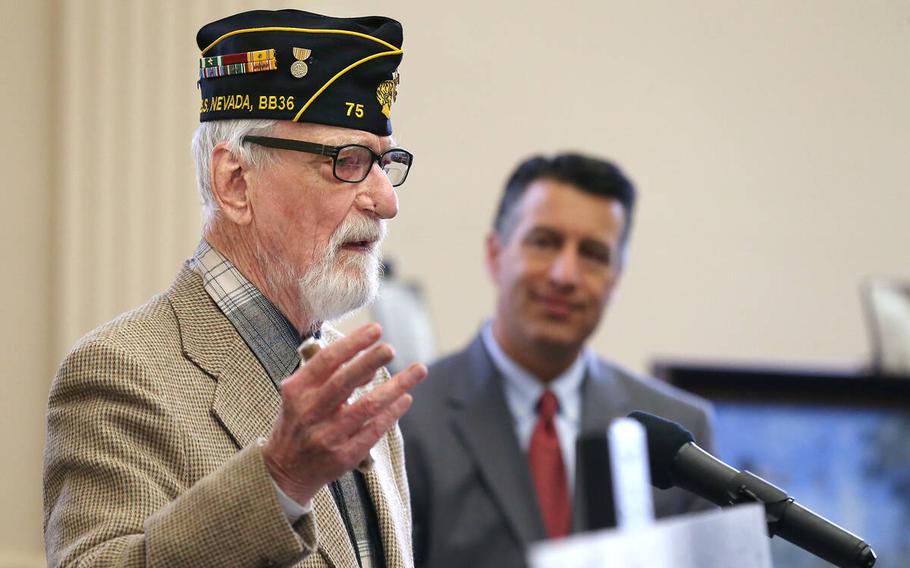
Pearl Harbor survivor Charles Sehe, with Gov. Brian Sandoval listening, speaks at the USS Nevada Centennial Ceremony at the Capitol in Carson City on March 11, 2016. Sehe was serving on the USS Nevada when it was attacked at Pearl Harbor. (Las Vegas Review-Journal)
(Tribune News Service) — One of the last two veterans who served on the USS Nevada during some of the most significant battles of World War II died Sunday at age 101.
Charles Sehe, who served on the ship during Pearl Harbor, the D-Day invasion at Normandy, France, and the 1945 invasions of Iwo Jima and Okinawa, lived in Mankato, Minn.
His death was confirmed by Brittany Renberg, funeral director of the Mankato Mortuary.
Dick Ramsey, who lives in Santa Clarita, Calif., and is now the last surviving crewman of the ship, said the loss of Sehe was “a shame.”
“He’s been a gentleman,” Ramsey told the Las Vegas Review-Journal on Monday. “I never heard him say a bad thing about anybody. And he will be missed. He’s the last shipmate I had, and that makes me the last man standing.”
Retired Rear Adm. Samuel Cox, director of the Naval History and Heritage Command, said: “He was a member of the U.S. Navy, a member of the Greatest Generation that fought the bloodiest war in human history to put an end to fascism and imperial aggression.”
At Normandy, the Nevada’s crew would have numbered about 2,200, Cox said.
Sehe was born in Geneva, Ill., on Feb. 26, 1923 to John and Frances Sehe, he said in a 2015 oral history interview.
When he enlisted in the Navy in November 1940, he was 17 years old and had to get his mother’s permission to join, he said. At the time, he didn’t know how to swim and couldn’t hit a target.
He was assigned to the Nevada, a 27,500-ton World War I-era battleship commissioned in 1916 and named for the 36th state.
In later years, Sehe wrote and spoke vividly of Pearl Harbor, an attack that damaged the Nevada with one torpedo and multiple bomb hits.
“We were all teenagers,” Sehe told the Review-Journal in 2015. “We didn’t join the Navy to fight a war, we fought to live. I was a stunned witness to the last moment of peace in America and her first moment of war.”
When the Japanese forces began attacking on Dec. 7, 1941, he wrote in one account, he ran to his battle station on a searchlight platform.
“Since the searchlights obviously were not utilized during daylight hours, all I could do was to watch this terrible, alarming, unbelievable nightmare unfold before my very eyes,” he said.
He witnessed the deaths of some of his shipmates and recalled wounded sailors covered with fuel oil being picked up from the burning water.
“After most of the major fires were put out, we turned our attention to removing the wounded and dead, who were then transferred to motor launches which came along side,” he wrote.
Sehe studied at North Central College in Naperville, Illinois, on the G.I. Bill after the war, then went to graduate school at the University of Iowa, where he earned a doctorate.
He had a long career as a professor of anatomy, zoology and endocrinology and retired from Mankato State University in 1990. He studied languages — French, German, Russian, Polish — and “just constantly had a thirst for knowledge,” his daughter Isabel Sehe said.
According to an obituary on the Mankato Mortuary website, his survivors besides Isabel Sehe include daughters Mari Ites, Kieran LoParco and Elizabeth Sehe as well as his son James Sehe.
His first visit to Nevada was in 2015, but John Galloway, a history enthusiast who has worked on USS Nevada-related projects, said Sehe felt a connection to the ship’s namesake state.
After a March 2016 commemoration of the USS Nevada’s 1916 commissioning, Galloway said he offered to bring Sehe to Hawaii for the 75th anniversary of Pearl Harbor.
But Sehe wasn’t interested. “If I’m going anywhere, I’m coming back here for the 75th anniversary,” Galloway said Sehe replied. “Because here, in this state, is where I feel the soul of the ship is.”
Sehe described the war years as the most impactful part of his life.
“This once 18-year-old sailor still cannot erase those tragic events from his memory bank,” he wrote. “Today, veterans often wonder why they were permitted to live and others died. Was it fate, or would it be that a Supreme Being had allowed some of us to survive the tragic horrors of war, while others had made their last full measure of devotion to their country?”
©2024 Las Vegas Review-Journal.
Visit reviewjournal.com.
Distributed by Tribune Content Agency, LLC.